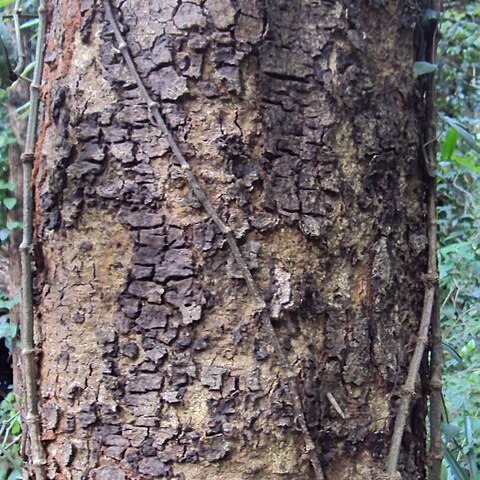Tree to 30(-43) m high, d.b.h. to 70(-140) cm. Branchlets slightly angular in the distal parts, terete, puberulous to tomentose, glabrescent. Stipules auriculate, c. 1-1.5 by 0.6-3 cm, usually visible in young branches and inflorescence, caducous. Leaves: rachis 10-25 cm, puberulous to tomentose, a gland c. 1.5-2 cm above the base, elliptic(-suburceolate), raised, c. 2-3 by 1-1.5 mm; pinnae 4-14 pairs, 4-14 cm, puberulous to tomentose, glabrescent, with glands at the junctions of the 1 or 2 distal pair(s) of leaflets, narrowly elliptic to slit-like, concave, c. 1 mm, or glands absent; leaflets (10-)20-31 pairs per pinna, opposite, sessile, thinly chartaceous; asymmetrically subulate, 6.5-10 by 1.5-3 mm, base truncate, apex sharply acute, at both sides sparsely sericeous or glabrous; main vein and margins sericeous to tomentose, main vein forming the front margin. Inflorescences consisting of pedunculate glomerules aggregated into terminal yellowish-green tomentose to hirsute panicles; peduncles up to 5 in clusters, often with auriculate stipules at the base, 1-3 cm long, bearing glomerules of 10-20 sessile or sub-sessile flowers. Flowers dimorphic, bisexual, pentamerous. Calyx tubular to narrowly campanulate, tomentose to hirsute, (2-)2.5-5 mm, teeth triangular, acute, 0.3 mm. Corolla funnel-shaped, puberulous to hirsute especially on the lobes, 6-10 mm, lobes triangular-ovate, acute, 2-2.5 mm. Stamens white at base, yellowish green at top, c. 20 mm, tube as long as to slightly longer than the corolla tube. Ovary glabrous, c. 3 mm, sessile. Pod yellowish-brownish, flat, straight, often with slightly sinuate margins, indehiscent or irregularly breaking up, 9-15 by 1.8-2 cm, valves rigidly chartaceous, glabrous, veins inconspicuous. Seeds elliptic, flattened, c. 7 by 4-5 by 0.5-1 mm; areole at the micropylar end, subcircular, c. 1 mm in diameter, open towards the hilum, pleurogram not parallel to the margin of the seed.
More
Trees, deciduous, to 30 m tall. Branchlets yellow pubescent. Stipules deciduous, cordate, large, membranous, apex apiculate; glands just below junctions of pinnae; pinnae 6-12 pairs; leaflets 20-35(-40) pairs, sessile, oblong-linear, falcate, 6-10 × 2-3 mm, abaxially villous, main vein close to upper margin, base subtruncate, margin ciliate, apex acuminate. Heads 10-20-flowered, arranged in a terminal panicle; peduncles long or short, densely villous. Flowers dimorphic, green-white or yellowish, densely yellow-brown tomentose. Calyx funnel-shaped, ca. 3 mm, shortly 5-toothed. Corolla ca. 2 × as long as calyx; lobes ovate-deltoid. Stamens ca. 2.5 cm, tube ca. as long as or slightly longer than corolla tube. Ovary yellow-brown villous, sessile. Legume indehiscent, or irregularly breaking up, plano-compressed, 10-15 × ca. 2 cm, slightly pubescent when young, glabrous when mature. Seeds elliptic, flat, ca. 7 × 4-5 mm; pleurogram minute, ca. 1 mm in diam., near micropyle. Fl. Mar-May, fr. Jun-Dec.
A tree. It loses its leaves during the year. It grows 30 m tall. The leaves have 6-12 pairs of pinnae and 20-35 pairs of leaflets. The flower heads have 10-20 flowers.
Can be grown by cuttings or seedlings. Seeds needs soaking.

